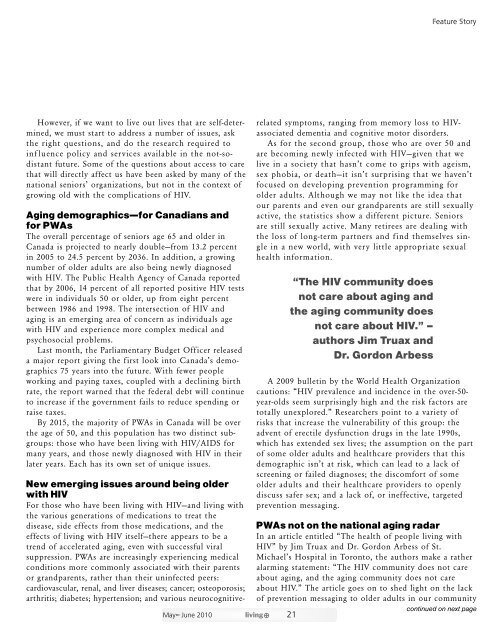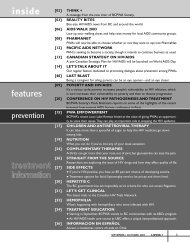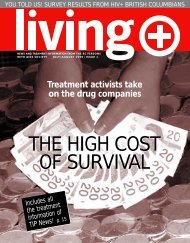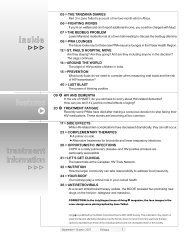liv poz mag.qxd - Positive Living BC
liv poz mag.qxd - Positive Living BC
liv poz mag.qxd - Positive Living BC
Create successful ePaper yourself
Turn your PDF publications into a flip-book with our unique Google optimized e-Paper software.
Feature Story<br />
However, if we want to <strong>liv</strong>e out <strong>liv</strong>es that are self-determined,<br />
we must start to address a number of issues, ask<br />
the right questions, and do the research required to<br />
inf luence policy and services available in the not-sodistant<br />
future. Some of the questions about access to care<br />
that will directly affect us have been asked by many of the<br />
national seniors’ organizations, but not in the context of<br />
growing old with the complications of HIV.<br />
Aging demographics—for Canadians and<br />
for PWAs<br />
The overall percentage of seniors age 65 and older in<br />
Canada is projected to nearly double—from 13.2 percent<br />
in 2005 to 24.5 percent by 2036. In addition, a growing<br />
number of older adults are also being newly diagnosed<br />
with HIV. The Public Health Agency of Canada reported<br />
that by 2006, 14 percent of all reported positive HIV tests<br />
were in individuals 50 or older, up from eight percent<br />
between 1986 and 1998. The intersection of HIV and<br />
aging is an emerging area of concern as individuals age<br />
with HIV and experience more complex medical and<br />
psychosocial problems.<br />
Last month, the Parliamentary Budget Officer released<br />
a major report giving the first look into Canada’s demographics<br />
75 years into the future. With fewer people<br />
working and paying taxes, coupled with a declining birth<br />
rate, the report warned that the federal debt will continue<br />
to increase if the government fails to reduce spending or<br />
raise taxes.<br />
By 2015, the majority of PWAs in Canada will be over<br />
the age of 50, and this population has two distinct subgroups:<br />
those who have been <strong>liv</strong>ing with HIV/AIDS for<br />
many years, and those newly diagnosed with HIV in their<br />
later years. Each has its own set of unique issues.<br />
MayqJune 2010 <strong>liv</strong>ing5 21<br />
New emerging issues around being older<br />
with HIV<br />
For those who have been <strong>liv</strong>ing with HIV—and <strong>liv</strong>ing with<br />
the various generations of medications to treat the<br />
disease, side effects from those medications, and the<br />
effects of <strong>liv</strong>ing with HIV itself—there appears to be a<br />
trend of accelerated aging, even with successful viral<br />
suppression. PWAs are increasingly experiencing medical<br />
conditions more commonly associated with their parents<br />
or grandparents, rather than their uninfected peers:<br />
cardiovascular, renal, and <strong>liv</strong>er diseases; cancer; osteoporosis;<br />
arthritis; diabetes; hypertension; and various neurocognitiverelated<br />
symptoms, ranging from memory loss to HIVassociated<br />
dementia and cognitive motor disorders.<br />
As for the second group, those who are over 50 and<br />
are becoming newly infected with HIV—given that we<br />
<strong>liv</strong>e in a society that hasn’t come to grips with ageism,<br />
sex phobia, or death—it isn’t surprising that we haven’t<br />
focused on developing prevention programming for<br />
older adults. Although we may not like the idea that<br />
our parents and even our grandparents are still sexually<br />
active, the statistics show a different picture. Seniors<br />
are still sexually active. Many retirees are dealing with<br />
the loss of long-term partners and f ind themselves single<br />
in a new world, with very little appropriate sexual<br />
health information.<br />
“The HIV community does<br />
not care about aging and<br />
the aging community does<br />
not care about HIV.” –<br />
authors Jim Truax and<br />
Dr. Gordon Arbess<br />
A 2009 bulletin by the World Health Organization<br />
cautions: “HIV prevalence and incidence in the over-50-<br />
year-olds seem surprisingly high and the risk factors are<br />
totally unexplored.” Researchers point to a variety of<br />
risks that increase the vulnerability of this group: the<br />
advent of erectile dysfunction drugs in the late 1990s,<br />
which has extended sex <strong>liv</strong>es; the assumption on the part<br />
of some older adults and healthcare providers that this<br />
demographic isn’t at risk, which can lead to a lack of<br />
screening or failed diagnoses; the discomfort of some<br />
older adults and their healthcare providers to openly<br />
discuss safer sex; and a lack of, or ineffective, targeted<br />
prevention messaging.<br />
PWAs not on the national aging radar<br />
In an article entitled “The health of people <strong>liv</strong>ing with<br />
HIV” by Jim Truax and Dr. Gordon Arbess of St.<br />
Michael’s Hospital in Toronto, the authors make a rather<br />
alarming statement: “The HIV community does not care<br />
about aging, and the aging community does not care<br />
about HIV.” The article goes on to shed light on the lack<br />
of prevention messaging to older adults in our community<br />
continued on next page











